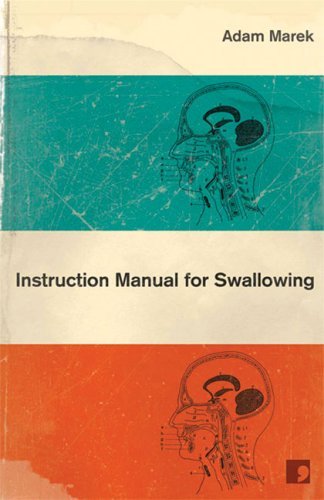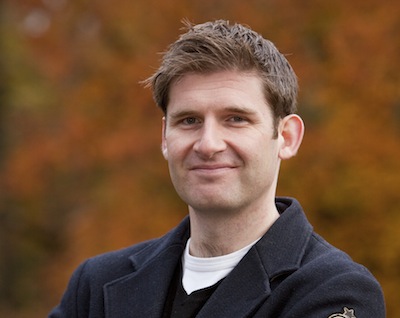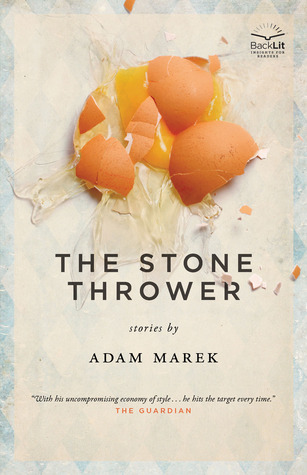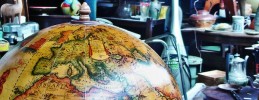
photo by Dan Pancamo
*
In her essay, shortlisted for the 2013 THRESHOLDS International Short Story Feature Writing Competition, Carys Bray recommends Adam Marek.
*
Comments from the judging panel:
‘A moving essay’; ‘a real testament, not only to the power of Marek as writer, but also to the power of stories’; ‘made hugely poignant and personal by the writer’s own story’; ‘a daring and generous piece – a privilege to read’; ‘an affecting illustration of the power of the surreal to explore the experiences of life for which realism is inadequate’; ‘this piece demonstrates why stories matter’.
*
by Carys Bray
I read Instruction Manual For Swallowing in one sitting, racing my way through the final story ‘Meaty’s Boys’, occasionally holding my breath as a group of zombie café employees performed a macabre trolley dash at a packing plant. When I finally closed the book I felt as if I had experienced something unique; I had never seen the short story do or be so many things.
Adam Marek’s second collection, The Stone Thrower, is just as good, but it has more focus and restraint, and there’s a single unifying theme that subtly echoes throughout. The children in this collection are fragile and their parents struggle to offer adequate protection. This makes for a more cohesive work, but Marek continues to set many of the stories in startling and strange worlds.
 The setting of the opening story ‘Fewer Things’ is perhaps the most ‘real’, but the location is so isolated that the young narrator feels as if he and his father are ‘the only people on the planet’. They set out each day to rescue tern chicks from knuckle fish and, while the boy wonders why parent birds feed chicks such dangerous food, the reader wonders about the emotional distance between father and son. The story is divided into seven scenes, some only a paragraph or two long, but each interaction is a revelation. When a guillemot chick is separated from its parents, father and son watch two big skuas squabble over it: ‘They jab at it with their beaks, which are thick and dark, like medieval weapons.’ The boy wants to rescue the chick, but his father won’t let him and as a result, the chick is eaten. ‘Fewer Things’ is a quietly devastating story about cruelty, kindness and the importance of judicious intervention. And so the tone of this collection is set; nature is brutal, relationships are complicated and even when characters inhabit recognisable worlds, they may have cause to feel as if they are utterly alone.
The setting of the opening story ‘Fewer Things’ is perhaps the most ‘real’, but the location is so isolated that the young narrator feels as if he and his father are ‘the only people on the planet’. They set out each day to rescue tern chicks from knuckle fish and, while the boy wonders why parent birds feed chicks such dangerous food, the reader wonders about the emotional distance between father and son. The story is divided into seven scenes, some only a paragraph or two long, but each interaction is a revelation. When a guillemot chick is separated from its parents, father and son watch two big skuas squabble over it: ‘They jab at it with their beaks, which are thick and dark, like medieval weapons.’ The boy wants to rescue the chick, but his father won’t let him and as a result, the chick is eaten. ‘Fewer Things’ is a quietly devastating story about cruelty, kindness and the importance of judicious intervention. And so the tone of this collection is set; nature is brutal, relationships are complicated and even when characters inhabit recognisable worlds, they may have cause to feel as if they are utterly alone.
The second story, ‘Dead Fish’, is set in a dystopian world where fisherman’s lines have hung dead for decades. ‘I hope you too have a taste for the unusual. For the brutal,’ the narrator warns the reader. In the world of this story there’s not enough to eat and the reader roots for hungry Rupi as he flees with a stolen fish. But it’s hard not to also feel sympathy for Alice – without the fish, her dinner party with the headmaster of St. Nathans will fail and her son will end up at John Hopworth’s, a school where a history teacher was burned alive in a toilet cubicle and new staff are routinely ‘balded’ by their students. The narrator’s warning about strangeness and brutality resounds throughout the collection. The Aleksander Academy pupils in ‘Without a Shell’ wear special, nano-fabric suits. Children from the neighbouring comprehensive, known as St. Fuckwits, are not similarly protected. Although the nano-suits are designed to preserve life, they encourage carelessness and, when Bucky hits a St. Fuckwit’s kid in the forehead with a stone during a scrap, Gayle says, ‘These kids didn’t cost their parents anything to make. If any of them didn’t get up again, their mum and dad could make another one for free.’ Invincibility has an adverse effect on the emotional health of the protected children. During a chilling final scene Bucky removes his suit, hoping Gayle will sting him so hard that she’ll ‘never be able to sting him again’.
Parents in The Stone Thrower frequently try to prevent pain but they sometimes inadvertently cause it. In ‘Remember the Bride who Got Stung’, Victor resorts to desperate measures as he tries to save his son’s life, while the father in ‘Tamagotchi’ must euthanize his son’s toy in order to prevent social suicide. ‘Tamagotchi’ is probably my favourite story. The final scene is particularly touching: the father stands at a window and watches rain bounce off the abandoned Tamagotchi which, in its utter incomprehensibility, is suddenly very like his son.
In a Guardian article entitled ‘My worries for my son became metaphors in my writing’, Adam Marek notes:
I guess that whenever you love anyone or anything in your life, that love comes pre-packaged with a fear of losing him or her or it. I hope that among the fantastical imagery of The Stone Thrower everyone will recognise something of his or her self.
 Marek’s words remind me of a Comma Press short story podcast in which Jeremy Dyson says, ‘The best stuff always has a little nugget of you or some felt thing, something real, something true… it needs to have that bit of grit in there for the oyster to coalesce around.’
Marek’s words remind me of a Comma Press short story podcast in which Jeremy Dyson says, ‘The best stuff always has a little nugget of you or some felt thing, something real, something true… it needs to have that bit of grit in there for the oyster to coalesce around.’
I find The Stone Thrower haunting and true and one evening, when I am listening to the news, I’m reminded of why this collection particularly resonates with me. The fertility watchdog has given the go-ahead for three-parent IVF babies, and the news reporter is excitedly explaining the process. I smile because I have just reread Marek’s ‘An Industrial Evolution’, a story that is prefaced by an excerpt from an article by Casper Stack, written after one Eleanor Lundgren breaches the conditions of her cloning permit to give birth to an orangutan: ‘The world has just become a different place’, Casper writes. ‘Another genie is out of the bottle.’ There are echoes of Casper’s wonder in the news reporter’s voice as he describes how three-parent IVF could lead to the elimination of diseases caused by defects in the DNA of mitochondria. It’s the word ‘mitochondria’ that particularly connects me to the strange and brutal world of The Stone Thrower.
When my first daughter is born she is quiet and sleepy. Soon after birth she loses consciousness. A team of specialist doctors arrive in a screaming ambulance. They dash down the corridor, a portable incubator coasting between them like a bobsled. My daughter is raced to another hospital, and hours and miles later, when I am finally allowed to join her, I find out she is blind. The consultant peels back her lids and the spheres underneath are uniformly blue-grey, like balls of glass or ice. I will learn Braille, I think. As soon as she is old enough I will teach her how to fill her darkness with stories.
As the days pass, her condition worsens and I learn she has a mitochondrial disease. These diseases are extremely rare – I don’t realise how rare until doctors who don’t work in Intensive Care start popping in to have a look. They try not to sound excited when they say “I’ve never seen this before”, and they thank me as they leave, making my creation of such an imperfect child seem deliberate and clever. I don’t know what mitochondria are; I scraped a B in GCSE Science, a subject I approached with all the enthusiasm of someone who had already selected humanities A-Levels. The consultant says the mitochondrion is the powerhouse of the cell. She says every cell in my daughter’s body is missing a vital metabolic enzyme, and although they have removed a slice of muscle and enough blood to require a transfusion, they don’t know what is missing.
The back cover of The Stone Thrower states, ‘sometimes only outright surrealism can do justice to the merciless strangeness of reality.’ I learn this as I sit beside my daughter. When the consultant says mitochondrial defects are inherited via the maternal line, I imagine a game of pass the parcel: my grandmother passes to my mother who passes to me and the music stops just as the genetic booby prize lands in my daughter’s lap. When there is talk of cloning, I envisage rows and rows of glassy-eyed babies, even though the consultant says the technique would only involve the replication of individual cells. As my daughter weakens, I picture tiny cell mechanics racing around her body in a last ditch effort to restart her engine. They push buttons and pull levers, but lactic acid continues to pour through permeable cell doors like something out of Titanic. The cell mechanics retreat. They batten down the hatches, allowing the kidneys to flood in an effort to save the heart. And they fail.
passes to me and the music stops just as the genetic booby prize lands in my daughter’s lap. When there is talk of cloning, I envisage rows and rows of glassy-eyed babies, even though the consultant says the technique would only involve the replication of individual cells. As my daughter weakens, I picture tiny cell mechanics racing around her body in a last ditch effort to restart her engine. They push buttons and pull levers, but lactic acid continues to pour through permeable cell doors like something out of Titanic. The cell mechanics retreat. They batten down the hatches, allowing the kidneys to flood in an effort to save the heart. And they fail.
Illness and disability can propel families into a dystopian, parallel universe. The landscape of this new world may be so foreign that it’s suddenly not a stretch to imagine children so fragile they come apart at the seams or life-threatening fits which cause metaphorical and literal earthquakes. And yet it’s not a uniformly gloomy world, in the same way that, despite the lingering sadness of many of the stories, The Stone Thrower is not a pessimistic collection. ‘A Thousand Seams’ ends with a mother’s promise: ‘I’m going to make everything okay,’ Molly says as she carries her fragile son through a jostling crowd; while the father in the title story desperately tries to protect his family from an uncanny stone thrower – and although his wife calls him ‘thick as pig shit’ in the ensuing mêlée, and everyone ends up ‘stranded in a sea of glass’, they are together, and they are safe.
Marek’s concluding, epistolary story ‘Earthquakes’ reads like a prayer. Amy Colkiss is soliciting funds for research into Sterna’s Syndrome, a condition in which childhood epilepsy affects things outside of the child’s body. ‘Please… I’m so scared of losing this opportunity,’ she writes. ‘It might be the last chance we get.’ This plea also acts like a gentle nudge to the reader – please don’t waste opportunities, make the most of every chance. Perhaps it’s a plea I can extend to future readers: don’t miss out on the opportunity to read the fantastical, grotesquely funny stories in Instruction Manual for Swallowing or the measured, haunting stories in The Stone Thrower. Take the chance now. You won’t regret it, I promise.
~
You can begin reading Adam Marek’s stories with ‘Remember the Bride who got Stung’, from The Stone Thrower, available on THRESHOLDS, here. And to find out more about Adam Marek, you can read a Q&A with the author himself here.


Beautiful essay Carys. Adam’s first collection blew me away and I’m sure the second one will too.
Thanks Dora! I’m sure you’ll enjoy The Stone Thrower, too. It has just been shortlisted for the Edge Hill Prize, so hopefully many more people will read it.